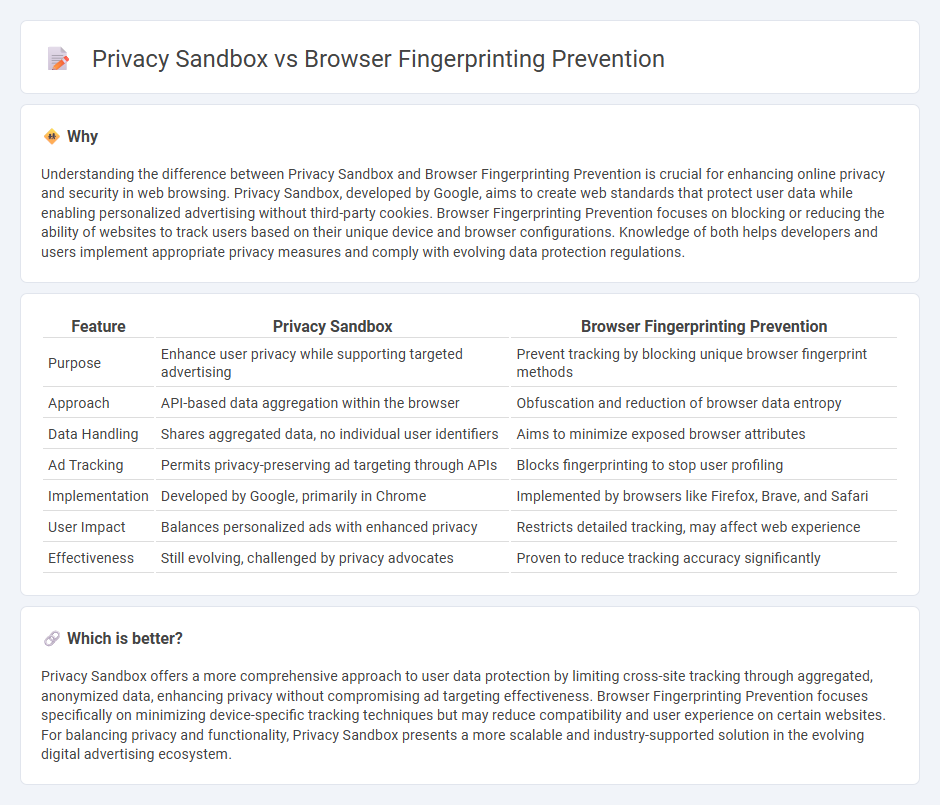
Privacy Sandbox offers a set of APIs designed to enhance user privacy by limiting cross-site tracking without compromising web functionality, aiming to replace third-party cookies with more secure alternatives. Browser fingerprinting prevention techniques focus on reducing the uniqueness of device and browser configurations to block covert tracking methods that collect detailed user data. Explore how these cutting-edge privacy solutions are transforming digital security and user experience.
Why it is important
Understanding the difference between Privacy Sandbox and Browser Fingerprinting Prevention is crucial for enhancing online privacy and security in web browsing. Privacy Sandbox, developed by Google, aims to create web standards that protect user data while enabling personalized advertising without third-party cookies. Browser Fingerprinting Prevention focuses on blocking or reducing the ability of websites to track users based on their unique device and browser configurations. Knowledge of both helps developers and users implement appropriate privacy measures and comply with evolving data protection regulations.
Comparison Table
| Feature | Privacy Sandbox | Browser Fingerprinting Prevention |
|---|---|---|
| Purpose | Enhance user privacy while supporting targeted advertising | Prevent tracking by blocking unique browser fingerprint methods |
| Approach | API-based data aggregation within the browser | Obfuscation and reduction of browser data entropy |
| Data Handling | Shares aggregated data, no individual user identifiers | Aims to minimize exposed browser attributes |
| Ad Tracking | Permits privacy-preserving ad targeting through APIs | Blocks fingerprinting to stop user profiling |
| Implementation | Developed by Google, primarily in Chrome | Implemented by browsers like Firefox, Brave, and Safari |
| User Impact | Balances personalized ads with enhanced privacy | Restricts detailed tracking, may affect web experience |
| Effectiveness | Still evolving, challenged by privacy advocates | Proven to reduce tracking accuracy significantly |
Which is better?
Privacy Sandbox offers a more comprehensive approach to user data protection by limiting cross-site tracking through aggregated, anonymized data, enhancing privacy without compromising ad targeting effectiveness. Browser Fingerprinting Prevention focuses specifically on minimizing device-specific tracking techniques but may reduce compatibility and user experience on certain websites. For balancing privacy and functionality, Privacy Sandbox presents a more scalable and industry-supported solution in the evolving digital advertising ecosystem.
Connection
Privacy Sandbox is a Google initiative aimed at creating web technologies that enhance user privacy while enabling targeted advertising, directly addressing concerns raised by browser fingerprinting techniques. Browser fingerprinting prevention methods reduce the ability to track users uniquely by limiting the data exposed through browsers. These two approaches work together to balance effective user tracking for advertising with stronger privacy protections.
Key Terms
Tracking Protection
Browser fingerprinting prevention techniques reduce tracking by obscuring unique device attributes, while Privacy Sandbox aims to replace third-party cookies with privacy-preserving APIs to limit cross-site tracking. Tracking Protection integrates both approaches, blocking fingerprinting scripts and restricting data shared with advertisers to safeguard user identity. Explore how these technologies work together to enhance user privacy in the evolving digital landscape.
Federated Learning of Cohorts (FLoC)
Browser fingerprinting prevention techniques reduce tracking by limiting the unique information browsers share, while Google's Privacy Sandbox introduces Federated Learning of Cohorts (FLoC) to group users based on browsing behavior, enhancing privacy by anonymizing individual identities within cohorts. FLoC aggregates user data locally on the device, enabling targeted advertising without exposing personal browsing histories, addressing concerns around traditional fingerprinting methods. Explore how FLoC balances user privacy with ad relevance to understand the future of web tracking and data protection.
Anti-Fingerprinting Techniques
Anti-fingerprinting techniques reduce the uniqueness of browser and device characteristics by standardizing data like user agents, screen resolution, and fonts, preventing trackers from creating distinct browser fingerprints. Privacy Sandbox initiatives introduce API-based solutions to replace covert tracking methods with transparent and privacy-preserving alternatives, aiming to phase out harmful fingerprinting practices without compromising ad relevance. Explore how evolving anti-fingerprinting strategies and Privacy Sandbox developments enhance user privacy and mitigate online tracking.
Source and External Links
What is Browser Fingerprinting and How Can You Clear It? - Use privacy-focused browsers like Tor or Brave, install anti-fingerprinting extensions such as uBlock Origin and Privacy Badger, disable JavaScript via extensions like NoScript, and adjust browser settings to resist fingerprinting (e.g., privacy.resistFingerprinting in Firefox).
What is browser fingerprinting? Here's how to prevent it | Privacy Bee - Keep your software updated, disable Flash and unnecessary plugins, browse in private or incognito mode, use the Tor browser for enhanced privacy, and avoid installing extensions that uniquely identify your browser.
How to Hide, Spoof, and Stop Browser Fingerprinting in 2025 - Employ anti-fingerprinting extensions like Privacy Badger and uBlock Origin, consider disabling JavaScript (with tools like NoScript), and use virtual browser profiles or spoofing techniques to mask your real browser fingerprint.
 dowidth.com
dowidth.com